Abstract
Synthetic aperture radar (SAR), which can generate images of regions or objects, is an important research area of radar. The chirp scaling algorithm (CSA) is a representative SAR imaging algorithm. The CSA has a simple structure comprising phase compensation and fast Fourier transform (FFT) operations by replacing interpolation for range cell migration correction (RCMC) with phase compensation. However, real-time processing still requires many computations and a long execution time. Therefore, it is necessary to develop a hardware accelerator to improve the speed of algorithm processing. In addition, the demand for a small SAR system that can be mounted on a small aircraft or drone and that satisfies the constraints of area and power consumption is increasing. In this study, we proposed a CSA-based SAR processor that supports FFT and phase compensation operations and presents field-programmable gate array (FPGA)-based implementation results. We also proposed a modified CSA flow that simplifies the traditional CSA flow by changing the order in which the transpose operation occurs. Therefore, the proposed CSA-based SAR processor was designed to be suitable for modified CSA flow. We designed the multiplier for FFT to be shared for phase compensation, thereby achieving area efficiency and simplifying the data flow. The proposed CSA-based SAR processor was implemented on a Xilinx UltraScale+ MPSoC FPGA device and designed using Verilog-HDL. After comparing the execution times of the proposed SAR processor and the ARM cortex-A53 microprocessor, we observed a 136.2-fold increase in speed for the 4096 × 4096-pixel image.
1. Introduction
The synthetic aperture radar (SAR) is an active sensor system that can acquire high-resolution radar images, regardless of day or night, flight altitude, and weather, using a microwave band [1,2,3]. Figure 1 shows the working principle of the SAR. In the SAR system, a small antenna is mounted on a platform that moves along a flight path. The direction of flight is also called the azimuth direction, and the range direction is perpendicular to the azimuth direction. The direction of the antenna is a range direction, and it moves by illuminating an area called a swath. Two-dimensional data on the azimuth and the range are collected by transmitting and receiving pulses. The central idea of the SAR is based upon matching filtering for both the azimuth and distance directions, which results in high-resolution radar images. In addition, the SAR has the advantage of remote sensing, so it plays a vital role in various fields, such as disaster emergency response, environmental protection, and military applications [3,4,5,6]. Because the traditional SAR system requires considerable computing resources and high power consumption, it has been mounted on large platforms such as aircraft and satellites. However, recent advances in digital signal processing and complementary metal oxide semiconductor (CMOS) technologies have made it possible to develop small and lightweight SAR systems. Accordingly, research on SAR systems with low power consumption and real-time processing is increasing [7,8,9].

Figure 1.
Illustration of the working principle of SAR.
Operations for SAR imaging mainly include the fast Fourier transform (FFT), inverse fast Fourier transform (IFFT), phase compensation, interpolation, etc., and the computational complexity of these operations is very high. Therefore, real-time SAR imaging necessitates accelerating these operations on various computing platforms, such as the central processing unit (CPU), the graphic processing unit (GPU), the field-programmable gate array (FPGA), and application-specific integrated circuits (ASICs) [9,10,11,12,13,14,15,16,17,18]. CPU and GPU provide high flexibility for software through various instructions and show high performance in single and parallel processing, respectively. However, high power consumption is still a severe challenge. On the other hand, FPGA has latency, throughput, and power consumption advantages compared with CPU or GPU. In addition, it has gained attention as a computing platform that can be used in various fields owing to its high flexibility [19,20].
Several studies have been conducted on the implementation of SAR systems using FPGAs. In 2004, Le et al. proposed an FPGA-based hardware architecture for a spaceborne system to process the range-Doppler and space–time adaptive processing (STAP) algorithms [9]. Greco et al. proposed an HW/SW interface framework to use FPGA resources efficiently through an abstraction layer and verified it in SAR applications and confirmed its performance [10]. Pfitzner et al. proposed an FPGA-based hardware architecture for airborne, real-time SAR imaging with integrated first-order motion compensation (MoCom) [11]. Lou et al. proposed a UAVSAR onboard processor for real-time and autonomous operations. They demonstrated the use of UAVSAR data to determine the flood extent, forest fire extent, lava flow, and landslide [12]. Choi et al. proposed a range-Doppler algorithm (RDA)-based SAR processor for real-time SAR imaging. In the case of RDA, interpolation is performed for range cell migration correction (RCMC). Therefore, all operations of RDA are accelerated by implementing an RCMC unit in addition to the FFT unit. However, the FFT unit adopts a pipelined structure, so there is room for speed improvement [13].
The most commonly used SAR Imaging algorithms include range-Doppler, chirp scaling, omega-K, polar format, and back projection. The RDA performs efficient imaging through block processing in the range and azimuth frequency domains; however, the complexity of interpolation for RCMC is very high. Therefore, the chirp-scaling algorithm (CSA) was developed by replacing the interpolation of RDA with phase compensation. CSA has a simple algorithm structure comprising FFT and phase compensation operations. In addition, CSA has an advantage of real-time imaging because it has the smallest computational load compared with the RDA and omega-K algorithms [21].
Several studies have been conducted to implement CSA on various platforms. Zhang et al. proposed a collaborative SAR imaging method that performs efficient task partitioning and scheduling. The entire image can be generated using deep collaborative multiple CPU–GPU computing. It acquired a 32,728 × 32,728-pixel image in 2.8 s [14]. Tang et al. proposed a simulator for spaceborne SAR onboard imaging on mobile GPUs. It acquired a 4096 × 4096-pixel image in 14.97 s [15]. Wang et al. proposed a heterogeneous processor consisting of fixed-point PE units and floating-point PE units. It acquired a 32,768 × 32,768-pixel image in 32.9 s at a speed of 200 MHz [16]. Li et al. proposed a method that employs single-instruction, multiple-data (SIMD) instructions and open multiprocessing (OpenMP) technology on multicore SIMD CPU to realize parallel optimization on CSA [17]. Di et al. proposed a schedulable and scalable multicore parallel architecture based on FPGA and mapped the fundamental CSA to the system. It acquired a 1024 × 4096-pixel image in 12 s [18].
Among the CSA operations, FFT/IFFT operations account for the highest proportion. Therefore, it is necessary to implement an FFT/IFFT processor for real-time imaging. The hardware structure of the FFT processor is divided into the butterfly, pipeline, and systolic array structures [22,23,24]. Butterfly and pipeline structures can be implemented with fewer hardware resources but are unsuitable for high-speed operations. Therefore, a systolic array-based FFT processor is suitable for real-time imaging [25,26]. Among the various systolic array structures, the base-4 systolic array structure is arithmetically efficient and has a good trade-off between area and speed [27,28]. Therefore, We adopted the base-4 systolic array structure.
In this paper, we propose a CSA-based SAR processor and present the results of accelerating the modified CSA flow, in which the order of transpose operation is changed in the traditional CSA flow. The proposed CSA-based SAR processor was implemented based on a base-4 systolic array architecture and can only perform FFT or FFT and phase compensation operations simultaneously. Twiddle factor multiplication and phase compensation were designed to share the same multiplier owing to their commonality of element-by-element multiplication, which made it possible to simplify the data flow and achieve area efficiency.
The remainder of this paper is organized as follows: Section 2 reviews the CSA and base-b FFT algorithm. Section 3 describes the modified CSA algorithm and the hardware architecture of the proposed CSA-based SAR processor. Section 4 presents the proposed processor’s implementation and the accelerated CSA results and compares the speed performance with previous studies. Finally, Section 5 concludes the paper.
2. Background
2.1. Chirp Scaling Algorithm
The CSA is one of the most popular algorithms for SAR imaging. It is instrumental because it can support strip-map, scan SAR, spotlight, sliding spotlight, tops, and mosaic modes, along with other pre- and post-processing steps [29,30]. The CSA operation has a simple algorithm structure comprising only FFT and phase compensation operations. Because signal processing is possible in the two-dimensional frequency domain, it is possible to solve the problem of secondary range compression (SRC), which depends on azimuth frequency. The computational complexity was reduced by replacing the interpolation operation for RCMC with phase compensation, which was performed in two steps: differential RCMC and bulk RCMC.
The traditional CSA flow is shown in Figure 2. SAR images can be obtained using four times FFT/IFFT and three times phase compensation operations. Differential RCMC to achieve chirp scaling is performed with the first-phase function, and bulk RCMC and range compression are performed using the second-phase function. Finally, the SAR image can be obtained through the third-phase function by performing azimuth compression and compensating for the residual phase.
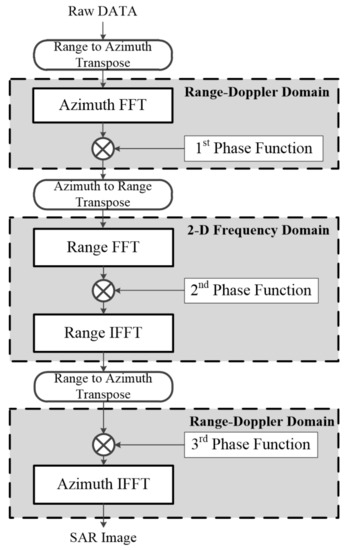
Figure 2.
Traditional CSA flow.
The transmission signal of a pulse-Doppler radar is assumed to be a linear frequency modulation (FM) chirp signal. The signal converted into the range-Doppler domain through the azimuth FFT is shown in Equation (1). Thus, all the targets in the same range of the closest approach collapse into one trajectory in the azimuth frequency domain [31].
where is the range time, is the azimuth frequency, A is the complex constant, c is the speed of light, is the migration factor in the range-Doppler domain, is the effective radar velocity, is the slant range of closest approach, is the azimuth FM rate of the point target signal, is the carrier frequency, and is the range FM of the point target signal in the range-Doppler domain. To adjust the range movement of the trajectory through the differential RCMC, phase compensation is performed using the first-phase function expressed by Equation (2), and the result can be expressed as Equation (3).
where is the reference azimuth frequency, and is the effective radar velocity in the reference range.
Equation (3) is transformed into a two-dimensional frequency domain with a range FFT, resulting in the signal given by Equation (4). There are five exponential terms, and compensation for these terms is performed through subsequent processing processes.
where is the complex constant, and is the range frequency. The second exponential term represents the range modulation after the scaling and includes the range–azimuth coupling corrected by the SRC. The fourth exponential term represents bulk range cell migration. The second-phase function performs range compression, SRC, and bulk RCMC by compensating for these two terms. The result is given by Equation (5).
Next, range IFFT is performed to transform the signal into the range-Doppler domain, and the result is given by Equation (6).
where is the complex constant, and is the range envelope. By multiplying Equation (6) by the third-phase function, the first exponential term representing the azimuth modulation and the second exponential term representing the residual phases can be compensated. Finally, azimuth IFFT is performed to transform the signal into the time domain. The signal of the point target is given by Equation (7).
where is the complex constant, is the IFFT of the window , and is the target phase.
2.2. Base-b FFT Algorithm
We adopted a base-b FFT algorithm based on two levels of transform factorization to compute the discrete Fourier transform (DFT) [28]. A DFT of length N is given by Equation (8).
where are the time-domain input values, are the frequency-domain outputs, and is the twiddle factor, . The matrix form of Equation (8) is given by Equation (9).
where C is the coefficient matrix containing the twiddle factor.
If the one-dimensional input data of length N can be decomposed into rows and columns, , n, and k can be represented by Equation (10). By substituting Equation (10), Equation (8) can be expressed as Equation (11).
For any particular value of n and k, the inner parenthesis value of Equation (12) can be evaluated in the dot product, as in Equation (13).
The matrix form of Y is given by Equation (15). values for all , can be expressed as a matrix of size . is a matrix of size and represents , and · means element-by-element multiplication. is a matrix of size and represents . Because X representing is a matrix of size , Y becomes a matrix of size .
Similarly to Y, the Z can be calculated from the dot product, as shown in Equation (16). Consequently, the matrix form for calculating Z is given by Equation (17).
where is a coefficient matrix of size and represents , which is equivalent to the transpose of . Z is a matrix of size and represents the result of the DFT.
In the base-b FFT algorithm, b is the value of , which can be used as a different value depending on the application. The base-b FFT algorithm is performed using two levels of transform factorization for one-dimensional data of length N. The first factorization is performed such that using the traditional row/column approach to lower the computational complexity. The second factorization is performed to and . FFT is performed through Equations (15) and (17) using the factorized result as an input.
FFT is performed in three steps. Column FFT is performed times in the row direction using column data with a length of . Next, the result of column FFT is multiplied by . Finally, row FFT is performed times in the column direction for row data with a length of . In summary, after transforming the one-dimensional data into a two-dimensional matrix of size , column FFT, multiplication, and row FFT are performed to obtain the FFT results.
3. Proposed HW Architecture
The CSA includes an FFT operation, which is a vector operation, and a phase compensation operation, which is a scalar operation (element-by-element multiplication). Therefore, for phase compensation, the desired result can be obtained by matching the axes of the SAR data and the phase function. Figure 3 shows the phase compensation operation with transposed data. The first row shows the operation results on the range axis, and the second row shows the operation results on the azimuth axis. The transpose of the result in the second row is the same as that in the first row.
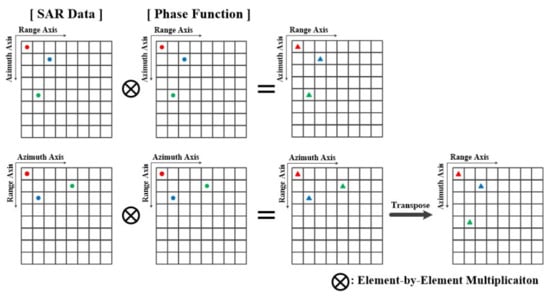
Figure 3.
Phase compensation operation with transposed data.
By performing transpose for the phase function, we changed the order in which data is transposed in the traditional CSA flow. Figure 4 shows the proposed modified CSA flow. We transposed the third-phase function and changed the transpose operation of the data from after range IFFT to after the third-phase compensation. The difference is that the third-phase compensation was performed on the range axis. FFT/IFFT and phase compensation operations were repeated three times as a new operation block, and then azimuth IFFT was performed to obtain SAR images. In the modified CSA flow 2, because the second and third blocks were both processed on the range axis, there was no need to store the data in the external memory to transpose the data. Accordingly, modified flow 2, which integrated the second and third blocks, was determined as the CSA processing flow.

Figure 4.
Modified CSA flows: (a) modified 1; (b) modified 2.
Figure 5 shows the FFT and phase compensation procedure, which is a repeated operation block in the modified CSA flow. The block operation proceeded in the order of column FFT, multiplication, row FFT, and phase compensation. Both the multiplication and phase compensation operations were element-by-element multiplications. Therefore, by repeating the row or column FFT and element-by-element multiplication twice, FFT and phase compensation could be performed. Thus, the operation block was accelerated by subdividing the FFT and the phase compensation operations into a row/column FFT and element-by-element multiplications.
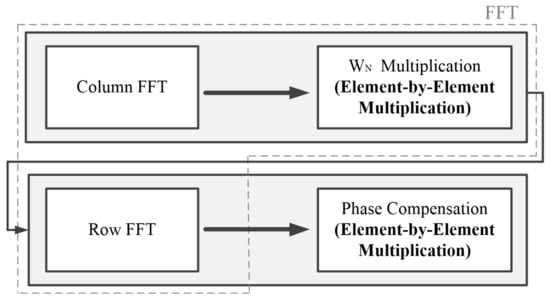
Figure 5.
Procedure of FFT and phase compensation.
Figure 6 shows the hardware architecture of the proposed CSA-based SAR processor. We adopted a base-4 systolic array that best satisfies the trade-off between area and execution time [27,28]. On the left, there is a bundle of processing element (PE) cells of size called left-hand side (LHS), and it is connected to a complex multiplier of size that multiplies . On the right, there is a bundle of PE cells of size called right-hand side, (RHS) and it is connected to four shared multipliers that perform multiplication or phase compensation operations depending on their input. At the bottom, there are four -sized memories to store the resulting values. Because both multiplication and phase compensation operations were element-by-element multiplication, multipliers could be shared. In addition, both operations were performed after the FFT, and the data flow was not disturbed. Therefore, we can achieve area efficiency without using an additional multiplier for the phase compensation operation. Because the proposed hardware supports a maximum of 4096-point operations, the LHS and RHS were PE cells of size, and the complex multipliers for had a size of .
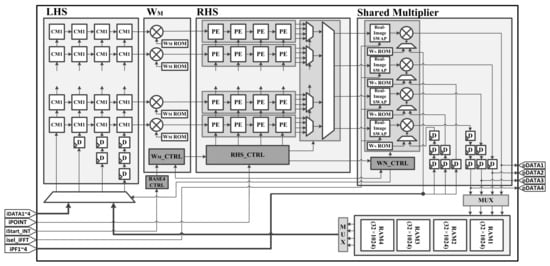
Figure 6.
Hardware architecture of the proposed CSA-based SAR processor.
The block operation proceeded in the following order: column FFT, multiplication, row FFT, and phase compensation. First, the SAR data were transferred to the LHS for column FFT, and matrix multiplication was performed with in the PE cell. By transmitting this result to the multiplier, the result of Equation (15) was obtained. Subsequently, the result was transferred to the RHS, and the result of Equation (17) was obtained by performing matrix multiplication with input under the RHS. This result was the same as that for column FFT. The result was transferred to the shared multiplier, and multiplication with the was performed. Then, the result was stored in the memory. The data stored in the memory were input to the LHS again in the row direction, and the operation was similarly performed up to the RHS. The result of the RHS was the same as that of FFT and transferred to the shared multiplier. However, unlike before, the phase function was input to the shared multiplier to perform phase compensation. Finally, the result for the FFT and phase compensation operation was stored in the memory.
If the phase factor is 1, it is possible to perform only FFT without phase compensation.
In a systolic array, PE cells are locally connected; each PE cell operates simultaneously, and data are delivered to the connected PE cell. It is suitable for algorithms that require a lot of computation because it has a local data flow, and multiple PE cells simultaneously process the computations [25]. A representative operation that can be accelerated using a systolic array is matrix multiplication. Figure 7 shows the two types of PE cells used in the proposed CSA-based SAR processor. For LHS, the data were derived from the lower PE cell, and multiplication and addition operations were performed in each PE cell. It passed through all PE cells by passing the input and the resulting values to each connected PE cell. If matrix A is sequentially input from the bottom, and the B matrix value exists inside the PE cell, can be obtained. For RHS, data were input from the bottom and left cells simultaneously. Similarly, multiplication and addition operations were performed, and the input and the resulting values were transferred to the connected PE cell. After passing through all PE cells, can be obtained. Using the PE array of these structures, the FFT operation expressed by Equations (15) and (17) in a matrix form was performed. Because matrix operations can be performed quickly through systolic arrays, FFT and phase compensation were processed at high speed.
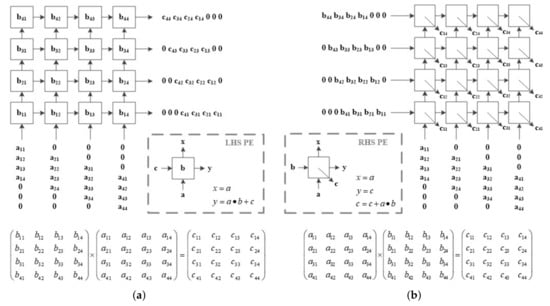
Figure 7.
Systolic Array Structure (a) LHS (Left Hand Side); (b) RHS (Right Hand Side).
4. Implementation and Acceleration Results
The proposed CSA-based SAR processor was configured on an FPGA platform using an advanced extensible interface (AXI) bus interface for verification. Figure 8 shows the FPGA platform, which includes a CSA-based SAR processor for FFT and phase compensation operations. The system structure comprised a CSA-based SAR processor, master interface to communicate with double data rate (DDR) memory, slave interface to communicate with a microprocessor, and cache RAM to store input/output data and phase functions. In addition, there was a register to change the operation mode because it supported the FFT and IFFT modes and variable lengths from 64 to 4096. The master interface was connected to the DDR memory controller via a 128-bit AXI bus, allowing the transfer of four 32-bit data points per clock cycle. Therefore, it operated efficiently in the base-4 systolic structure, in which four points of data were input in parallel.

Figure 8.
FPGA platform for the verification of the proposed CSA-based SAR processor.
The proposed CSA-based SAR processor was implemented using a Verilog HDL on a Xilinx Zynq UltraScale+ FPGA device. The CSA-based SAR processor was implemented with 17,326 CLB registers, 31,025 CLB LUTs, 4 block RAMs, and 78 DSPs, as listed in Table 1. The CSA-based SAR processor could process at a maximum operating frequency of 235 MHz, and its power consumption was measured to be 1.31 W. Figure 9 shows the verification environment of the FPGA platform.

Table 1.
Implementation results based on the Xilinx Zynq UltraScale+ FPGA device.

Figure 9.
Verification environment for the proposed FPGA implementation.
When SAR data were loaded into the DDR memory to verify the CSA-based SAR processor, the microprocessor sent a starting signal to the CSA-based SAR processor. The DDR data were then transferred to the cache RAM through the master interface. The CSA-based SAR processor performed azimuth FFT and first-phase compensation operations and stored the result in the cache RAM; the result was transferred back to the DDR via the master interface for the transpose operation. After the transpose operation, the range FFT and second-phase compensation operations were similarly performed. According to the modified CSA flow 2, transposing the result was unnecessary. Therefore, the result was not transmitted to the DDR, and the CSA-based SAR processor performed range IFFT and third-phase compensation operations on the data in the cache RAM and then transmitted the result to the DDR. After performing the transpose operation again, the SAR image was obtained by performing the same operation for the azimuth IFFT. Therefore, SAR images can be obtained by performing four times CSA-based SAR processor operations.
Figure 10 and Figure 11 show the imaging results for the four-point targets. Figure 10 shows the results of imaging using the traditional CSA flow, and Figure 11 shows the results using the modified CSA flow. The third-phase compensation of the modified CSA flow was performed on the range axis, and the result of completing the range axis operation is shown in Figure 11c. Therefore, as shown in Figure 11d, the imaging result can be obtained through only the azimuth IFFT. However, for traditional CSA flow, a third-phase compensation operation was performed on the azimuth axis. Figure 10c shows the result of completing the range-axis operation, and Figure 10d shows the data of Figure 10c in the time domain. The operation of the range axis was completed, but the azimuth compression had not yet been performed, which was a distinct difference from the modified CSA flow. We analyzed the peak signal-to-noise ratio (PSNR) [32] based on the numerical error and structural similarity index map (SSIM) [33] based on the structural similarity of images as metrics to evaluate the SAR image quality. The PSNR was measured at 35.44 dB, which is higher than 30 dB, and the SSIM was measured at 0.9544.

Figure 10.
Point target simulation results with traditional CSA flow: (a) raw data in time domain; (b) differential RCMC result in R/D domain; (c) range compression and bulk RCMC result in R/D domain; (d) range compression and bulk RCMC result in time domain; (e) azimuth compression result in time domain.
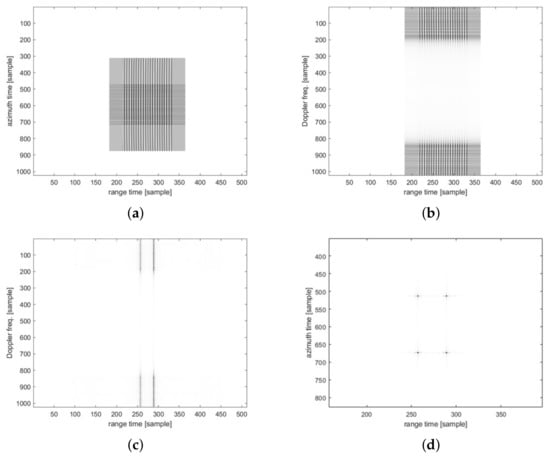
Figure 11.
Point target simulation results with modified CSA flow: (a) raw data in time domain; (b) first block result in R/D domain; (c) second block result in R/D domain; (d) third block result in time domain.
For validation using actual SAR data, we used the RADARSAR-1 dataset, an image of Vancouver, Canada, from RADARSAT-1’s Fine Beam 2 [31]. The software processing results using ARM Cortex-A53 were used as references to evaluate the image quality of the proposed hardware results. Figure 12 shows the SAR images obtained after processing the actual SAR data. The PSNR and SSIM were measured at 33.43 dB and 0.9466, respectively. Compared with the results for point targets, PSNR and SSIM were slightly degraded because actual SAR data contained clutter and interference. However, the image quality was still good, as shown in Figure 12.

Figure 12.
SAR images derived using (a) ARM Cortex-A53-based SW and (b) the proposed FPGA-based HW.
Table 2 presents the evaluation results of the CSA execution time. The acceleration results obtained using the CSA-based SAR processor and ARM Cortex-A53 are presented for various image sizes. According to the modified CSA flow, all CSA operations were accelerated by the CSA-based SAR processor. The experimental results indicate that the execution time decreased from about 267.56 s to 1.96 s for 4096 × 4096-pixel image, resulting in a 136.2-fold acceleration.

Table 2.
CSA execution time.
Table 3 compares the execution times of the proposed CSA-based SAR processor with previous studies performed on various computing platforms. Because the sizes of the images presented by each study were different, the execution time per pixel is additionally presented for comparison, and the unit is nanoseconds (ns). The authors of [14] achieved the fastest speed using a combination of a CPU and GPU. However, the power consumption was 345 W, which is unsuitable for small platforms. In [16], the authors proposed an array-based heterogeneous processor. Each PE cell performed a four-point butterfly operation, and 512 PE cells were used. Furthermore, additional multipliers were used to perform the phase compensation operation. However, the proposed design did not use other resources for phase compensation operations and used 128 PE cells. Assuming that the 4-point butterfly unit used in [16] used 4 adders and 3 multipliers, 2048 adders and 1536 multipliers were used. In contrast, each PE cell of the proposed design used 1 adder and 1 multiplier; thus, 128 adders and 128 multipliers were used. The difference in the number of calculators used in the PE cell was 16 times for the adder and 12 times the multiplier, which led to a significant difference in execution time (approximately 3.19 times). Therefore, the proposed design could achieve a faster speed per unit area than that in [16]. A comparison of the results is presented in Table 4. Compared with [12,15,17], the proposed architecture achieved a higher speed and consumed less power, making it suitable for small SAR platforms.

Table 3.
Comparison with previous implementation.

Table 4.
Comparison of PE unit with [16].
5. Conclusions
In this study, we proposed a CSA-based SAR processor based on a systolic array. The CSA-based SAR processor supports FFT and phase compensation operations. The multiplier used for the FFT operation was designed to be shared for phase compensation. Therefore, an additional multiplier for phase compensation was not required, and the area efficiency could be achieved. The proposed architecture is suitable for a modified CSA flow, which changes the order of transpose operation from the traditional CSA flow. We confirmed the imaging result using actual SAR data. The proposed processor was implemented using 17,326 CLB registers, 31,025 CLB LUTs, 4 block RAMs, and 78 DSPs on a Xilinx Zynq UltraScale+ FPGA device. Compared with the execution time of the ARM Cortex-A53-based software for an image of 4096 × 4096 pixels, we achieved an approximately 136.2-fold acceleration. We computed the execution time normalized by the number of pixels and compared the results with those of previous studies. Compared with previous studies conducted on various platforms, the CSA-based SAR processor achieved the fastest speed per the number of calculators or power.
Future research will involve the implementation of ASIC usable in small SAR platforms based on the proposed design verified through FPGA. In addition, we expect to implement this model in more power-efficient platforms.
Author Contributions
J.L. designed the CSA-based SAR processor, performed the experiment and evaluation, and wrote the paper. D.J., S.L., M.L. and W.L. implemented the processor and performed the revision of this manuscript. Y.J. conceived of and led the research, analyzed the experimental results, and wrote the paper. All authors have read and agreed to the published version of the manuscript.
Funding
The authors gratefully acknowledge the support from the Next-Generation SAR Research Laboratory at Korea Aerospace University, originally funded by the Defense Acquisition Program Administration (DAPA) and Agency for Defense Development (ADD).
Institutional Review Board Statement
Not applicable.
Informed Consent Statement
Not applicable.
Data Availability Statement
Not applicable.
Conflicts of Interest
The authors declare no conflict of interest.
References
- Chan, Y.K.; Koo, V. An introduction to synthetic aperture radar (SAR). Prog. Electromagn. Res. B 2008, 2, 27–60. [Google Scholar] [CrossRef]
- Curlander, J.C.; McDonough, R.N. Synthetic Aperture Radar; Wiley: New York, NY, USA, 1991; Volume 11. [Google Scholar]
- Soumekh, M. Synthetic Aperture Radar Signal Processing with MATLAB Algorithms; Wiley: New York, NY, USA, 1999; Volume 7. [Google Scholar]
- Percivall, G.S.; Alameh, N.S.; Caumont, H.; Moe, K.L.; Evans, J.D. Improving disaster management using earth observations—GEOSS and CEOS activities. IEEE J. Sel. Top. Appl. Earth Obs. Remote Sens. 2013, 6, 1368–1375. [Google Scholar] [CrossRef]
- Joyce, K.E.; Belliss, S.E.; Samsonov, S.V.; McNeill, S.J.; Glassey, P.J. A review of the status of satellite remote sensing and image processing techniques for mapping natural hazards and disasters. Prog. Phys. Geogr. 2009, 33, 183–207. [Google Scholar] [CrossRef]
- Gierull, C.H.; Vachon, P.W. Foreword to the special issue on multichannel space-based SAR. IEEE J. Sel. Top. Appl. Earth Obs. Remote Sens. 2015, 8, 4995–4997. [Google Scholar] [CrossRef]
- Svedin, J.; Bernland, A.; Gustafsson, A.; Claar, E.; Luong, J. Small UAV-based SAR system using low-cost radar, position, and attitude sensors with onboard imaging capability. Int. J. Microw. Wirel. Technol. 2021, 13, 602–613. [Google Scholar] [CrossRef]
- Saif, A.; Dimyati, K.; Noordin, K.A.; Alsamhi, S.H.; Hawbani, A. Multi-UAV and SAR collaboration model for disaster management in B5G networks. Internet Technol. Lett. 2021, 4, e310. [Google Scholar] [CrossRef]
- Le, C.; Chan, S.; Cheng, F.; Fang, W.; Fischman, M.; Hensley, S.; Johnson, R.; Jourdan, M.; Marina, M.; Parham, B.; et al. Onboard FPGA-based SAR processing for future spaceborne systems. In Proceedings of the IEEE 2004 Radar Conference, Philadelphia, PA, USA, 29 April 2004; pp. 15–20. [Google Scholar]
- Greco, J.; Cieslewski, G.; Jacobs, A.; Troxel, I.A.; George, A.D. Hardware/software interface for high-performance space computing with FPGA coprocessors. In Proceedings of the IEEE Aerospace Conference, Big Sky, MT, USA, 4–11 March 2006; pp. 1–10. [Google Scholar]
- Pfitzner, M.; Cholewa, F.; Pirsch, P.; Blume, H. FPGA based architecture for real-time SAR processing with integrated motion compensation. In Proceedings of the Synthetic Aperture Radar, Tsukuba, Japan, 23–27 September 2013; pp. 521–524. [Google Scholar]
- Lou, Y.; Clark, D.; Marks, P.; Muellerschoen, R.J.; Wang, C.C. Onboard radar processor development for rapid response to natural hazards. IEEE J. Sel. Top. Appl. Earth Obs. Remote Sens. 2016, 9, 2770–2776. [Google Scholar] [CrossRef]
- Choi, Y.; Jeong, D.; Lee, M.; Lee, W.; Jung, Y. Fpga implementation of the range-doppler algorithm for real-time synthetic aperture radar imaging. Electronics 2021, 10, 2133. [Google Scholar] [CrossRef]
- Zhang, F.; Li, G.; Li, W.; Hu, W.; Hu, Y. Accelerating spaceborne SAR imaging using multiple CPU/GPU deep collaborative computing. Sensors 2016, 16, 494. [Google Scholar] [CrossRef]
- Tang, H.; Li, G.; Zhang, F.; Hu, W.; Li, W. A spaceborne SAR on-board processing simulator using mobile GPU. In Proceedings of the 2016 IEEE International Geoscience and Remote Sensing Symposium (IGARSS), Beijing, China, 10–15 July 2016; pp. 1198–1201. [Google Scholar]
- Wang, S.; Zhang, S.; Huang, X.; An, J.; Chang, L. A highly efficient heterogeneous processor for SAR imaging. Sensors 2019, 19, 3409. [Google Scholar] [CrossRef]
- Li, G.; Zhang, F.; Ma, L.; Hu, W.; Li, W. Accelerating SAR imaging using vector extension on multi-core SIMD CPU. In Proceedings of the 2015 IEEE International Geoscience and Remote Sensing Symposium (IGARSS), Milan, Italy, 26 June–1 July 2015; pp. 537–540. [Google Scholar]
- Di, W.; Chen, C.; Liu, Y. FPGA-Based Multi-core Reconfigurable System for SAR Imaging. In Proceedings of the IGARSS 2018-2018 IEEE International Geoscience and Remote Sensing Symposium, Valencia, Spain, 22–27 July 2018; pp. 8921–8924. [Google Scholar]
- Seng, K.P.; Lee, P.J.; Ang, L.M. Embedded intelligence on FPGA: Survey, applications and challenges. Electronics 2021, 10, 895. [Google Scholar] [CrossRef]
- Babu, P.; Parthasarathy, E. Reconfigurable FPGA architectures: A survey and applications. J. Inst. Eng. Ser. B 2021, 102, 143–156. [Google Scholar] [CrossRef]
- Cruz, H.; Véstias, M.; Monteiro, J.; Neto, H.; Duarte, R.P. A Review of Synthetic-Aperture Radar Image Formation Algorithms and Implementations: A Computational Perspective. Remote Sens. 2022, 14, 1258. [Google Scholar] [CrossRef]
- Baas, B. A 9.5 mW 330/spl mu/sec 1024-point FFT processor. In Proceedings of the IEEE 1998 Custom Integrated Circuits Conference, Santa Clara, CA, USA, 14 May 1998; pp. 127–130. [Google Scholar]
- He, S.; Torkelson, M. Design and implementation of a 1024-point pipeline FFT processor. In Proceedings of the 1998 Custom Integrated Circuits Conference, Santa Clara, CA, USA, 14 May 1998; pp. 131–134. [Google Scholar]
- Lee, M.K.; Shin, K.W.; Lee, J.K. A VLSI array processor for 16-point FFT. IEEE J. Solid-State Circuits 1991, 26, 1286–1292. [Google Scholar] [CrossRef]
- Kung, H.T. Why systolic architectures? Computer 1982, 15, 37–46. [Google Scholar] [CrossRef]
- Kung, S.Y. VLSI array processors. IEEE ASSP Mag. 1985, 2, 4–22. [Google Scholar] [CrossRef]
- Lim, H.; Swartzlander, E.E. Multidimensional systolic arrays for the implementation of discrete Fourier transforms. IEEE Trans. Signal Process. 1999, 47, 1359–1370. [Google Scholar]
- Nash, J.G. Computationally efficient systolic architecture for computing the discrete Fourier transform. IEEE Trans. Signal Process. 2005, 53, 4640–4651. [Google Scholar] [CrossRef]
- Chen, Q.; Yu, A.; Sun, Z.; Huang, H. A multi-mode space-borne SAR simulator based on SBRAS. In Proceedings of the 2012 IEEE International Geoscience and Remote Sensing Symposium, Munich, Germany, 22–27 July 2012; pp. 4567–4570. [Google Scholar]
- Stangl, M.; Werninghaus, R.; Schweizer, B.; Fischer, C.; Brandfass, M.; Mittermayer, J.; Breit, H. TerraSAR-X technologies and first results. IEE Proc. Radar Sonar Navig. 2006, 153, 86–95. [Google Scholar] [CrossRef]
- Cumming, I.G.; Wong, F.H. Digital processing of synthetic aperture radar data. Artech House 2005, 1, 108–110. [Google Scholar]
- Hu, A.; Zhang, R.; Yin, D.; Chen, Y.; Zhan, X. Perceptual quality assessment of SAR image compression. Int. J. Remote Sens. 2013, 34, 8764–8788. [Google Scholar] [CrossRef]
- Wang, Z.; Bovik, A.C.; Sheikh, H.R.; Simoncelli, E.P. Image quality assessment: From error visibility to structural similarity. IEEE Trans. Image Process. 2004, 13, 600–612. [Google Scholar] [CrossRef]
Disclaimer/Publisher’s Note: The statements, opinions and data contained in all publications are solely those of the individual author(s) and contributor(s) and not of MDPI and/or the editor(s). MDPI and/or the editor(s) disclaim responsibility for any injury to people or property resulting from any ideas, methods, instructions or products referred to in the content. |
© 2023 by the authors. Licensee MDPI, Basel, Switzerland. This article is an open access article distributed under the terms and conditions of the Creative Commons Attribution (CC BY) license (https://creativecommons.org/licenses/by/4.0/).